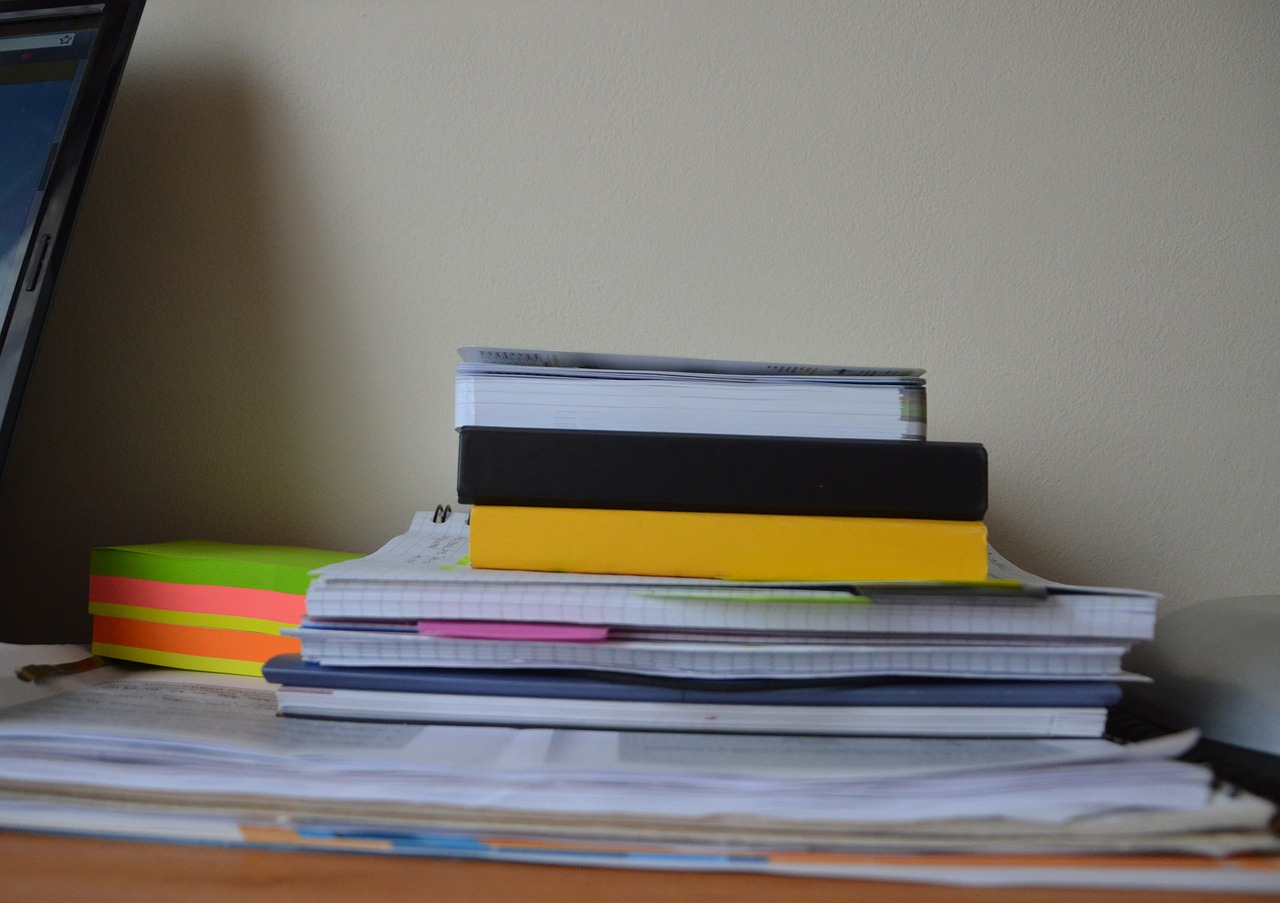 When we are homeschooling, it can at times seem like we don’t have enough space or a place for all our stuff as we squeeze life in between all the books, papers, art supplies, projects, kits… not to mention all that our children bring in from outside. A house that’s more like a Smithsonian than Better Homes and Gardens truly can be organized, neat and tidy. Our goal is to create an inspiring environment that is going to be supportive and thriving rather than a stressful, cluttered one that’s in need of constant management. Let’s be honest — for the self-educator there are a lot more things to be interested and involved in besides constantly cleaning, sorting and organizing.
When we are homeschooling, it can at times seem like we don’t have enough space or a place for all our stuff as we squeeze life in between all the books, papers, art supplies, projects, kits… not to mention all that our children bring in from outside. A house that’s more like a Smithsonian than Better Homes and Gardens truly can be organized, neat and tidy. Our goal is to create an inspiring environment that is going to be supportive and thriving rather than a stressful, cluttered one that’s in need of constant management. Let’s be honest — for the self-educator there are a lot more things to be interested and involved in besides constantly cleaning, sorting and organizing.
“Out of clutter, find Simplicity. From discord, find Harmony. In the middle of difficulty lies opportunity.” — Albert Einstein
It’s time to get it organized once and for all. Here are five simple steps to an organized homeschool.
- Get the whole family organized. Let’s not try to reorganize the whole house at once. These types of projects can get messy, and just before you start getting everything nice and neat in its place you can find yourself taking on too much too soon. Pace yourself. Choose one area at a time to work on, complete it and then move on to the next area. Don’t convince yourself that it will be easier to just do it all yourself for the sake of it being done “right.” As you’re homeschooling you should allow for more time at home, being able to train your children in new skills. Organizing and managing a home is a very important skill that will serve them for a lifetime. When you want to tackle a specific area, discuss it with your children and ask them for their input. Share your ideas on how you want to improve and organize the area. Create a plan and implement it together. If you’re letting go of items some children can be attached to, allow them to grow through it and gently guide them to let go and realize that what they need is available without having to hold onto a lot of stuff. This is an important lesson and best if learned from the time they are little. For older children, you can show and tell them what’s to be done, do it together so they can see how it’s done, ask them to do it as you watch and guide. Then it’s time to step aside and let them do the task. Keep in mind that everyone works in a different way, and allow them to do the work before inspecting the job. As the reorganization is completed, be sure that everyone knows where things belong, and if you have a new routine allow time for everyone to make the change. The only way they will be able to keep up with your new system is through clear and caring communication and practice in the new habits.
- Keep your organizing simple for children to manage easily. It’s easy for adults to get involved in complicated systems of organization. It can make sense to us, but what about your children? Since they will be participating in keeping the system flowing on an everyday basis, it needs to be low maintenance. You need to be sure to keep it simple, not only so they can easily manage but also so you don’t have to keep managing it on top of everything else you do. Can they see where all of the supplies are? Do you use clear boxes for storage and easy-to-access baskets? Age-appropriate supplies need to be reachable for your younger children. Can you dedicate a closet, cabinet or chest of drawers to supplies, games and kits? Keeping everything together keeps it simple.
- Keep what you need and get rid of the rest. Do you have too much stuff? The answer is yes if you can’t keep it neat and have to keep re-organizing it over and over again. Have you run out of space? This means it’s time to evaluate if you really need to keep so much stuff. Is it time to let go? Most self-educators have wide interests so it can be easy to accumulate a lot, but if we keep it narrowed down to what we really value and what we are using day in and day out we quickly realize that we don’t need so much stuff. How many toys are in your child’s room that are never played with? I’ve asked my children to create a list of the top five interests they value the most and consider sharing the rest with children who might not have so much. They are usually quick to donate and share their items. Your time together enjoying life is more meaningful than being shackled to constantly managing stuff. If you have any children who are attached and don’t want to let go of anything try putting what they don’t list as their top five interests in a box then revisit it in six months to a year to see if they’ve accessed it. Chances are they will realize they’ve outgrown it, or no longer have an interest, and are ready to give it away.
-

Image: Pixabay
Keep out only what you’re using. Piles of books and papers can accumulate quickly. Make it a priority to have a place for everything and everything in its place. Have current books, texts and notebooks on a shelf, in a drawer or in a basket by the area where the child does his academic work. The easier it is to put things away the neater the area will remain. Help your children learn the habit of putting away what they’re done with immediately rather than having to come back and clean up. This saves a lot of time and energy. What does your desk look like, Dad and Mom? I’ve noticed that when I let my desk get cluttered then I see my children making the same little piles on their desk and on the floor around their desk. As I clean up they become inspired to clean their areas. Getting rid of this clutter and having cleared spaces allows more energy to flow and everyone in the home feels better. Having all those little piles cleaned up is a big relief for mom, because as we are going through our day just seeing little piles is draining our energy; we’re always feeling like we need to clean up more but never have time to get to it. Don’t forget to work as a team, because together everyone achieves more.
- File it and forget it. As you homeschool each and every day, your children are writing papers, doing pages of math, creating drawings and artwork, so what do you do with all of this? It’s so easy to allow it to pile up. I know, because I’ve done plenty myself over the years. Rather than creating a never ending “to file” pile, file it and forget it. You need to create a system for managing papers on a daily basis as well as weekly and long-term. Over the course of the next month I am going to be working closely with my Inner Circle members with an easy-to-use system for children and parents to use. It’s important to keep certain papers, and there are some papers you may feel like you want to have as keepsakes. Again, this is a case for having a place for everything and everything in its place. When you know that you’re being responsible with your paperwork and recordkeeping you can feel good and no longer have any worries about it. I hope you will join us in the Inner Circle!
In Elaine St. James’ book, Simplify Your Life with Kids, she gives us good reasons to be organized and live a simpler life. “Raising happy, healthy, well-adjusted children is one of our greatest challenges. Kids require incredible amounts of our love, understanding, patience, praise, nurturing, guidance, respect and thought. And these things all take time. If you can simplify even one or two areas of your life, it will vastly improve the quality and increase the quantity of time you have to spend with your kids. And your family life will be much easier and a lot more fun, as it should be.”
Parents Inspired to Action:
Start at step one of the five steps listed above, and begin bringing order and calm to your home and homeschool. Remember, only work on one area at a time and move to the next area after completely finishing the area you started with. Do you need more information and inspiration about organizing? Here are two of my favorite books on the subject. Check your local library or Amazon for these titles: The Beverly Hills Organizer’s Home Organizing Bible: A Pro’s Answers to Your Organizing Prayers by Linda Koopersmith, and What’s a Disorganized Person To Do? By Stacey Platt.
Children Inspired to Action:
As you make changes, you need to be sure to bring along the children. Take time to sit and talk with your children. Ask them for their input and really listen to what they are saying. Tackle your organizing projects together, and as they get older you might be surprised to find them organizing drawers and closets for you. These are all important life skills, so don’t discount them, and make time for these life lessons at home. They may need to be on the project for shorter time spans than you, but as you guide them through the process, they are learning. Many hands makes work lighter.
“Once you have a clear picture of your priorities — that is values, goals, and high leverage activities — organize around them.” — Stephen Covey
Think peace, live love.

